1640-1649 Civil War and Regicide
1640-1649 Civil War and Regicide is in 17th Century Events.
Attack on Lambeth Palace
On 11 May 1640 apprentices attacked Lambeth Palace [Map].
Evelyn's Diary. 10 Jun 1640. London, and especially the Court, were at this period in frequent disorders, and great insolences were committed by the abused and too happy City: in particular, the Bishop of Canterbury's (age 66) Palace [Map] at Lambeth was assaulted by a rude rabble from Southwark, Surrey [Map], my Lord Chamberlain (age 55) imprisoned and many scandalous libels and invectives scattered about the streets, to the reproach of Government, and the fermentation of our since distractions: so that, upon the 25th of June, I was sent for to Wotton, Surrey [Map], and the 27th after, my father's (age 53) indisposition augmenting, by advice of the physicians he repaired to the Bath, Somerset [Map].
Second Bishop's War
Between Jun 1640 and Oct 1640 the Second Bishop's War was an attack by the Scottish Covenanters into England against King Charles I of England, Scotland and Ireland (age 39). The Scots crossed into Northumberland reaching Newcastle upon Tyne [Map]. In Oct 1640 King Charles I of England, Scotland and Ireland (age 39) sued for peace.
Battle of Newburn
On 28 Aug 1640 the Battle of Newburn was fought at the Newburn [Map] ford over the River Tyne between the Scottish army of 20,000 men commanded by Alexander Leslie 1st Earl Leven (age 60) and the English army of 5000 commanded by Edward Conway 2nd Viscount Conway (age 46). The Scottish army was successful.

Treaty of Ripon
On 26 Oct 1640 the Treaty of Ripon was a peace treaty signed by King Charles I of England, Scotland and Ireland (age 39) to cease the war with Scotland in the North. Charles agreed the Scots could retain large parts of northern England, and to pay them £850 per day until the Aug 1641 1641 Treaty of London.
Evelyn's Diary. 30 Dec 1640. I saw his Majesty (age 40) (coming from his Northern Expedition) ride in pomp and a kind of ovation, with all the marks of a happy peace, restored to the affections of his people, being conducted through London with a most splendid cavalcade; and on the 3d of November following (a day never to be mentioned without a curse), to that long ungrateful, foolish, and fatal Parliament, the beginning of all our sorrows for twenty years after, and the period of the most happy monarch in the world: Quis talia fando!
Trial and Execution of the Earl of Strafford
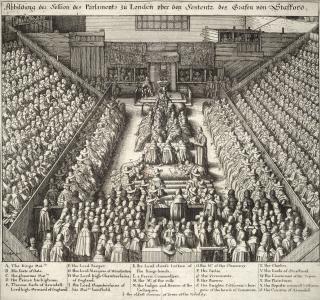 On 13 Apr 1641 Thomas Wentworth 1st Earl Strafford (age 48) was attainted by 204 votes to 59 ostensibly for his authoritarian rule as Lord Deputy of Ireland. Despite his promise not to King Charles I of England, Scotland and Ireland (age 40) signed the death warrant on the 10 May 1641 in the light of increasing pressure from Parliament and the commons.
On 13 Apr 1641 Thomas Wentworth 1st Earl Strafford (age 48) was attainted by 204 votes to 59 ostensibly for his authoritarian rule as Lord Deputy of Ireland. Despite his promise not to King Charles I of England, Scotland and Ireland (age 40) signed the death warrant on the 10 May 1641 in the light of increasing pressure from Parliament and the commons.

Wenceslaus Hollar (age 33). Engraving of the Trial of Thomas Wentworth 1st Earl Strafford (age 48) with the following marked:
A. King Charles I of England, Scotland and Ireland (age 40).
C. Henrietta Maria Bourbon Queen Consort England (age 31).
D. King Charles II of England Scotland and Ireland (age 10).
E. Thomas Howard 21st Earl of Arundel 4th Earl of Surrey 1st Earl Norfolk (age 55), Lord High Steward.
F. Henry Montagu 1st Earl Manchester (age 78), Lord Keeper of the Great Seal.
G. John Paulet 5th Marquess Winchester (age 43).
H. Robert Bertie 1st Earl Lindsey (age 58), Lord Chamberlain.
I. Philip Herbert 4th Earl Pembroke 1st Earl Montgomery (age 56), Lord Chamberlain of the Household.
V. Thomas Wentworth 1st Earl Strafford (age 48).
Z. Alethea Talbot Countess Arundel, Surrey and Norfolk (age 56).
Wenceslaus Hollar: On 23 Jul 1607 he was born. Pepy's Diary. 22 Nov 1666. Up, and to the office, where we sat all the morning, and my Lord Bruncker did show me Hollar's new print of the City, with a pretty representation of that part which is burnt, very fine indeed; and tells me that he was yesterday sworn the King's servant, and that the King hath commanded him to go on with his great map of the City, which he was upon before the City was burned, like Gombout of Paris, which I am glad of. On 25 Mar 1677 he died.
Evelyn's Diary. 15 Apr 1641 I repaired to London to hear and see the famous trial of the Earl of Strafford, Lord-Deputy of Ireland (age 48), who, on the 22nd of March, had been summoned before both Houses of Parliament, and now appeared in Westminster Hall [Map], which was prepared with scaffolds for the Lords and Commons, who, together with the King (age 40), Queen (age 31), Prince (age 10), and flower of the noblesse, were spectators and auditors of the greatest malice and the greatest innocency that ever met before so illustrious an assembly. It was Thomas Earl of Arundel and Surrey (age 55), Earl Marshal of England, who was made High Steward upon this occasion; and the sequel is too well known to need any notice of the event.



Evelyn's Diary. 12 May 1641, I beheld on Tower-hill [Map] the fatal stroke which severed the wisest head in England from the shoulders of the Earl of Strafford (age 48), whose crime coming under the cognizance of no human law, or statute, a new one was made, not to be a precedent, but his destruction. With what reluctancy the King (age 40) signed the execution, he has sufficiently expressed; to which he imputes his own unjust suffering - to such exorbitancy were things arrived.

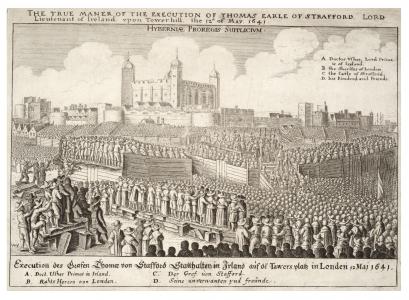 On 12 May 1641 Thomas Wentworth 1st Earl Strafford (age 48) was beheaded at Tower Hill [Map]. His execution was attended by an enormous crowd.
On 12 May 1641 Thomas Wentworth 1st Earl Strafford (age 48) was beheaded at Tower Hill [Map]. His execution was attended by an enormous crowd.
Wenceslaus Hollar (age 33). Engraving of the execution of Thomas Wentworth 1st Earl Strafford (age 48) marked as C with James Ussher (age 60) marked as A.
Battle of La Marfée
On 06 Jul 1641 Louis Bourbon Condé Count Soissons (age 37) was killed at the Battle of La Marfée. His sister Marie Bourbon Condé Countess Soissons (age 35) succeeded Countess Soissons 1367.
Jul 1641 Creation of Baronets
On 14 Jul 1641 King Charles I of England, Scotland and Ireland (age 40) created new Baronets:
John Cotton 1st Baronet (age 25) was created 1st Baronet Cotton of Landwade in Cambridgeshire.
Thomas Abdy 1st Baronet (age 29) was created 1st Baronet Abdy of Felix Hall in Kelveden in Essex.
John Bampfylde 1st Baronet (age 31) was created 1st Baronet Bampfylde of Poltimore in Devon.
On 29 or 30 Jul 1641 William Strickland 1st Baronet (age 45) was created 1st Baronet Strickland of Boynton in Yorkshire. Frances Finch Lady Strickland by marriage Lady Strickland of Boynton in Yorkshire.

1641 Treaty of London
On 26 Oct 1640 the Treaty of Ripon was a peace treaty signed by King Charles I of England, Scotland and Ireland (age 39) to cease the war with Scotland in the North. Charles agreed the Scots could retain large parts of northern England, and to pay them £850 per day until the Aug 1641 1641 Treaty of London.
Evelyn's Diary. 23 Nov 1641. I returned to London; and, on the 25th, saw his Majesty (age 41) ride through the City after his coming out of Scotland, and a Peace proclaimed, with great acclamations and joy of the giddy people.
1641 Irish Rebellion
On 23 Oct 1641 the 1641 Irish Rebellion was an attempt by Catholic gentry to seize Dublin Castle. The Rebellion was foiled when details of its plot were revealed to Owen O'Connolly who informed the Irish Justices. The leaders were arrested.
In 1645 Connor Maguire 2nd Baron of Enniskillen (age 29) was hanged, drawn and quartered at Tyburn [Map].
King Charles I Attacks Parliament
On 04 Jan 1642 King Charles I of England, Scotland and Ireland (age 41) sent soldiers into Parliament to arrest a five MPs: Pym, John Hampden (age 46), Hazlerigg, Holies and Strode (age 44). They had received warning and sought safety. After this Civil War was certain, and men began to choose their side.


Battle of Liscarroll
In Jul 1642 David Barry 1st Earl Barrymore (age 37) led a regiment at the Battle of Liscarroll.
Battle of Powick Bridge
On 23 Sep 1642 Maurice Palatinate Simmern (age 21) was wounded at during the Battle of Powick Bridge. 
Lawrence Carey (age 32) was killed.
Charles Lucas (age 29) was wounded.
Siege of Portsmouth
Between 10 Aug 1642 and 07 Sep 1642 Portsmouth, Hampshire [Map] was besieged by Parliamentary forces.
In Sep 1642 William Waller (age 45) concluded the Siege of Portsmouth.
Evelyn's Diary. 03 Oct 1642. To Chichester [Map], and hence the next day to see the Siege of Portsmouth; for now was that bloody difference between the King and Parliament broken out, which ended in the fatal tragedy so many years after. It was on the day of its being rendered to Sir William Waller (age 45); which gave me an opportunity of taking my leave of Colonel Goring (age 34), the governor, now embarking for France. This day was fought that signal battle at Edgehill. Thence I went to Southampton, Hampshire [Map] and Winchester, Hampshire [Map], where I visited the castle, school, church, and King Arthur's Round Table; but especially the church [Map], and its Saxon kings' monuments, which I esteemed a worthy antiquity.
Europeans Discover New Zealand
On 18 Sep 1642 Dutch Seafarer Abel Janszoon Tasman anchored his two ships near Wainui in Mohua (Golden Bay). He was the first European visitor to visit Aotearoa, New Zealand. Tasman is responsible for the name New Zealand ie Nieuw Zeeland. Tasman sent boats to gather water which were attacked by Māori; four of his men were killed.
Battle of Edge Hill
Evelyn's Diary. 03 Oct 1642. To Chichester [Map], and hence the next day to see the Siege of Portsmouth; for now was that bloody difference between the King and Parliament broken out, which ended in the fatal tragedy so many years after. It was on the day of its being rendered to Sir William Waller (age 45); which gave me an opportunity of taking my leave of Colonel Goring (age 34), the governor, now embarking for France. This day was fought that signal battle at Edgehill. Thence I went to Southampton, Hampshire [Map] and Winchester, Hampshire [Map], where I visited the castle, school, church, and King Arthur's Round Table; but especially the church [Map], and its Saxon kings' monuments, which I esteemed a worthy antiquity.
On 14 Oct 1642 Richard Newport 1st Baron Newport (age 55) was created 1st Baron Newport of High Ercall in Shropshire; by King Charles I of England, Scotland and Ireland (age 41) in return for having provided £6000 for the purchase of artillery before the Battle of Edge Hill.

On 23 Oct 1642 the Battle of Edge Hill was fought at Edge Hill [Map]. The Royal army was commanded by King Charles I of England, Scotland and Ireland (age 41) (with his son King Charles II of England Scotland and Ireland (age 12) present), Prince Rupert Palatinate Simmern 1st Duke Cumberland (age 22) and Richard Spencer (age 49) commanded the army that included Maurice Palatinate Simmern (age 21), Richard Byron 2nd Baron Byron (age 36), Lucius Carey 2nd Viscount Falkland (age 32), Charles Cavendish (age 22), Henry Newton aka Puckering 3rd Baronet (age 24), Spencer Compton 2nd Earl of Northampton (age 41), Thomas Salusbury 2nd Baronet (age 30), John Byron 1st Baron Byron (age 43) and William Feilding 1st Earl Denbigh (age 55).









George Stewart 9th Seigneur D'Aubigny (age 24) was killed.
Of the Parliamentary army Basil Feilding 2nd Earl Denbigh (age 34) and Robert Devereux 3rd Earl Essex (age 51). Oliver St John 5th Baron St John (age 39) was wounded.


Samuel Sandys (age 27) commanded a troop of horse.
Richard Sandys (age 26) was killed.
Thomas Strickland (age 20) was knighted on the field for his gallantry.
Henry Hunloke 1st Baronet (age 24) was knighted by King Charles I of England, Scotland and Ireland (age 41).
William Dugdale (age 37) witnessed the battle and subsequently surveyed the battlefield.
John Hinton (age 38) was present.
Edward Verney (age 52) was killed.
John Assheton (age 29) was killed.
Robert Bertie 1st Earl Lindsey (age 59) was killed. His son Montagu Bertie 2nd Earl Lindsey (age 34) succeeded 2nd Earl Lindsey, 15th Baron Willoughby de Eresby. Martha Cockayne Countess Lindsey and Holderness by marriage Countess Lindsey.

William Pennyman 1st Baronet (age 35) commanded a regiment, of which he served as Colonel, which he led for the King.
Edward Stradling 2nd Baronet (age 42) fought for the King, was captured imprisoned for seven months, and died a month after his release.
Battle of Brentford
Evelyn's Diary. 12 Nov 1642. The 12th of November was the Battle of Brentford, surprisingly fought; and to the great consternation of the City, had his Majesty (age 41) (as it was believed he would) pursued his advantage. I came in with my horse and arms just at the retreat; but was not permitted to stay longer than the 15th, by reason of the army marching to Gloucester, Gloucestershire [Map]; which would have left both me and my brothers exposed to ruin, without any advantage to his Majesty (age 41).
On 12 Nov 1642 the Battle of Brentford was a small pitched battle which took place on 12 November 1642, between a detachment of the Royalist army (predominantly horse with one regiment of Welsh foot) under the command of Prince Rupert (age 22), and two infantry regiments of Parliamentarians with some horse in support. The result was a victory for the Royalists.
Birth of Isaac Newton
On 25 Dec 1642 Isaac Newton was born to Isaac Newton and Hannah Ayscough posthumously at Woolsthorpe Manor [Map]. His father had died three months before Isaac was born.

Battle of Hopton Heath
On 19 Mar 1643 William Compton (age 18) and James Compton 3rd Earl of Northampton (age 20) fought for the Royalist army at Hopton Heath Hopton, Staffordshire.
Spencer Compton 2nd Earl of Northampton (age 41) was killed. His son James Compton 3rd Earl of Northampton (age 20) succeeded 3rd Earl of Northampton, 4th Baron Compton of Compton in Warwickshire.
Battle of Camp Hill
On 03 Apr 1643 a company of Parliamentarians from the Lichfield garrison with the support of some of the local townsmen, approximately 300 men, attempted to stop a detachment of 1,400 Royalists under the command of Prince Rupert (age 23) from passing through the unfortified parliamentary town of Birmingham.
William Feilding 1st Earl Denbigh (age 56) was wounded during the Battle of Camp Hill.
Battle of Stratton
On 16 May 1643 Henry Grey 1st Earl Stamford (age 44) fought for the Parliamentary army at Stratton, Cornwall. 
Battle of Gainsborough
After Mar 1643 the town of Gainsborough [Map] was placed under the command of the Royalist Robert Pierrepont 1st Earl Kingston (age 58) from which they harassed Parliamentarians in Lincolnshire. Royalist attacks at Louth and Market Rasen, together with the capture of gunpowder intended for Rotherham, provoked Parliament into action.
On 16 Jul 1643 Francis Willoughby 5th Baron Willoughby of Parham launched a night attack on Gainsborough [Map] and captured it and Robert Pierrepont 1st Earl Kingston (age 58).

On 25 Jul 1643 Robert Pierrepont 1st Earl Kingston (age 58) Was accidentally shot and killed while a prisoner on board a vessel bound for Hull. His son Henry Pierrepont 1st Marquess Dorchester (age 37) succeeded 2nd Earl Kingston upon Hull, 2nd Viscount Newark, 2nd Baron Pierrepont of Holme Pierrepoint. Catherine Stanley Marchioness Dorchester by marriage Countess Kingston upon Hull.

On 28 Jul 1643 the Parliamentary arms commanded by Oliver Cromwell (age 44) and the Royalist army commanded by Charles Cavendish (age 23) fought at the Battle of Gainsborough at North Scarle.

Charles Cavendish (age 23) was killed by James Berry. He was buried at Newark on Trent, Nottinghamshire [Map].
On 04 Aug 1643 the Royalist Newdigate Poyntz (age 34) died probably from wounds received at the battle.
On 31 Jul 1643 Francis Willoughby 5th Baron Willoughby of Parham surrendered Gainsborough [Map] to William Cavendish 1st Duke Newcastle upon Tyne (age 50) after a three day siege.

Destruction of Cheapside Cross
On 04 May 1643 the Cheapside Cross [Map] was destroyed by order of the Committee for the Demolition of Monuments of Superstition and Idolatry.
Battle of Lansdowne
On 05 Jul 1643 the Battle of Lansdowne was an inconclusive battle between a Royalist army commanded by Ralph Hopton 1st Baron Hopton (age 47) and a Parliamentary Army commanded by William Waller (age 46) at Lansdown Hill, Bath. The two commanders being old friends.
Edward Leke was killed.
Bevil Grenville (age 48) was killed at the at the head of the Cornish infantry as it reached the top of Lansdown Hill. He received a blow to the head with a pole-axe and was taken to the rectory at nearby Cold Ashton, Gloucestershire where he died.
Battle of Roundway Down
On 13 Jul 1643 a Royalist cavalry force under Lord Wilmot (age 30) won a crushing victory over the Parliamentarian Army of the West under Sir William Waller (age 46) at Roundway Down Devizes, Wiltshire.
Maurice Palatinate Simmern (age 22) fought.
Siege of Bristol
In 1643 Edward Fitton 2nd Baronet (age 40) died of consumption at the Siege of Bristol without surviving issue. He was buried at the Church of St James, Gawsworth [Map]. Baronet Fitton of Gawsworth Hall extinct.
Originally a canopied monument what remains of the canopy is fixed to the wall. His daughter Margaret Fitton who predeceased him kneeling.
Edward Fitton 2nd Baronet: In 1603 he was born to Edward Fitton 1st Baronet and Anne Barratt. Before 1631 Edward Fitton 2nd Baronet and Jane Trevor were married.
Margaret Fitton: Around 1631 she was born to Edward Fitton 2nd Baronet and Jane Trevor. In 1638 Margaret Fitton died.
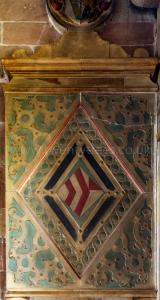
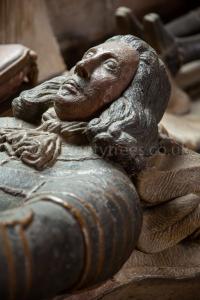
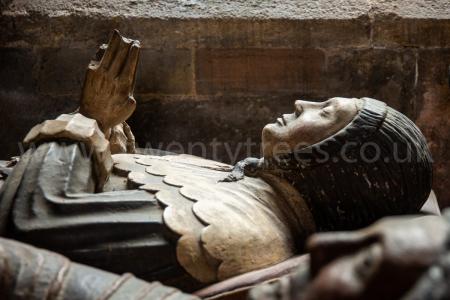
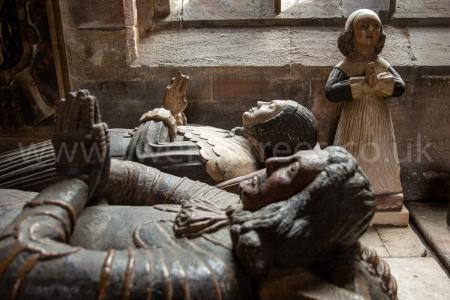
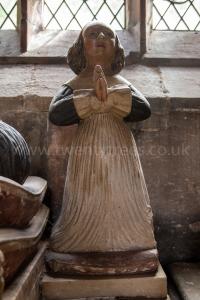
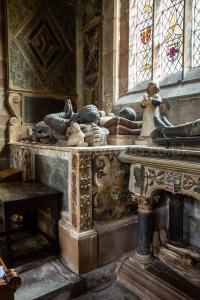
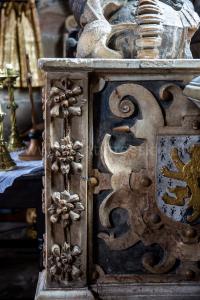
Battle of Portlester
On 07 Aug 1643 Charles Moore 2nd Viscount Moore of Drogheda (age 40) was killed at Ballivor, County Meath. His son Henry Moore 1st Earl Drogheda (age 21) succeeded 3rd Viscount Moore of Drogheda, 3rd Baron Moore of Mellefont in Louth.
First Battle of Newbury
On 20 Sep 1643 the First Battle of Newbury was fought at Newbury, Berkshire [Map] with King Charles I of England, Scotland and Ireland (age 42) commanding the Royalist army and Robert Devereux 3rd Earl Essex (age 52) commanding the victorious Parliamentary army. For King Charles I of England, Scotland and Ireland (age 42) John Byron 1st Baron Byron (age 44) fought with distinction.


Henry Bertie was killed.
Robert Dormer 1st Earl Carnarvon (age 33) was killed. His son Charles Dormer 2nd Earl Carnarvon (age 10) succeeded 2nd Earl Carnarvon, 3rd Baron Dormer of Wyng in Buckinghamshire, 3rd Baronet Dormer of Wyng in Buckinghamshire.
William Villiers 2nd Viscount Grandison (age 29) was killed. His brother John Villiers 3rd Viscount Grandison succeeded 3rd Viscount Grandison.
Edward Villiers (age 23) fought.
Lucius Carey 2nd Viscount Falkland (age 33) was killed. His son Lucius Carey 3rd Viscount Falkland (age 11) succeeded 3rd Viscount Falkland.
Richard Neville (age 28) served under the Earl Carnarvon (age 33). Carnarvon was killed and Neville took up the command as a Colonel of Horse.

Major General Charles Fleetwood (age 25) was wounded.
After 20 Sep 1643. Monument to Lucius Carey 2nd Viscount Falkland (deceased) who was killed at the First Battle of Newbury and who is buried in St Michael & All Angels Church, Great Tew [Map]. The inscription reads:
This tablet is erected to record the fact that LUCIUS CAREY, VISCOUNT FALKLAND distinguished in the time of Charles the First is buried in this Church. The exact spot where his remains lie is not known, nor was there, so far as is known, any memorial to him in this Church until the erection of the present one in 1885, but his burial at Tew is certified by the parish register He fell fighting on the side of the King in the battle of Newbury, on the 20th September 1643, in the 34th year of his age. He was lord of the manor of Great Tew, and resided at Tew, attracting round him there a society of learned friends from Oxford, as is mentioned by Clarendon, who has celebrated his worth with an eloquent pen and with the warmth of friendship. The praises of Clarendon are confirmed by Sir Philip Warwick, Waller and Cowley, who all extol the eminence of his natural gifts and the variety and extent of his learning. But that which has yet more contributed to keep his memory and shed lustre upon it, is the admiration which he won by his fine and blameless character.
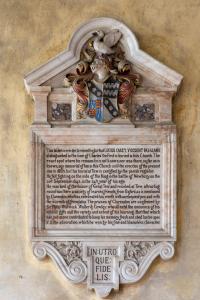
On 27 Oct 1644 Anthony Mansel of Ischoed was killed at the First Battle of Newbury fighting for the Royalists.
Battle of Cheriton
On 29 Mar 1644 John Stewart (age 22) was killed during the Battle of Cheriton fighting for the Royalists.
Battle of Oswestry
On 22 Jun 1644 Francis Newport 1st Earl Bradford (age 24) was captured during the Battle of Oswestry fighting for the Royalists.
Battle of Cropredy Bridge
On 29 Jun 1644 the Battle of Cropredy Bridge was fought near Banbury, Oxfordshire [Map].
Robert Howard (age 18) fought.
James Harington 3rd Baronet (age 36) led out a brigade of suburban Trained Bands, the Tower Hamlets Regiment and the Southwark White Auxiliaries and the Westminster Yellow Auxiliaries, to join William Waller (age 47) in the campaign that culminated at the Battle of Cropredy Bridge.
Battle of Marston Moor
On 02 Jul 1644 the Battle of Marston Moor was fought near Tockwith [Map] in Yorkshire. Alexander Seton aka Montgomerie 6th Earl Eglinton (age 56) fought for the Royal army. Lionel Carey (age 22) was killed. John Hay 1st Marquess Teviotdale (age 18) fought for the Parliamentary army.

At the Battle of Marston Moor Lucas (age 31) swept Fairfax's Yorkshire horse before him, but later in the day he was taken prisoner, in a battle won decisively by Parliament.
John Dolben (age 19) fought for the Royalists.
William Eure was killed.
Philip Musgrave 2nd Baronet (age 37) fought for the Royalists.
John Fenwick (age 42) was killed.
Baptism of Henrietta Maria
On 21 Jul 1644 Princess Henrietta Stewart Duchess Orléans was baptised at Exeter Cathedral [Map]. John Berkeley 1st Baron Berkeley (age 42) attended. Elizabeth Villiers Countess Morton (age 35) was her godmother in whose care she was left.


Second Battle of Newbury
On 27 Oct 1644 Mountjoy Blount 1st Earl Newport (age 47) fought for the Royalist Army at the Second Battle of Newbury.
On 27 Oct 1644 Maurice Palatinate Simmern (age 23) fought for the defeated Royalist army at the Second Battle of Newbury at Speen, Newbury [Map]. Thomas Wentworth 1st Earl Cleveland (age 53) was captured. Edward St John (age 27) was killed.


James Harington 3rd Baronet (age 36), who had his horse shot from under him, commanded five regiments.
Execution of Alexander Carew 2nd Baronet
On 19 Nov 1644 Alexander Carew 2nd Baronet (age 35) was tried for treason, for attempting to betray the Parliamentary cause, by court-martial and convicted at Guildhall [Map].
On 23 Dec 1644 Alexander Carew 2nd Baronet (age 35) was beheaded at Tower Hill [Map]. His son John Carew 3rd Baronet (age 9) succeeded 3rd Baronet Carew of Antony in Cornwall.
Trial and Execution of the Hothams
Around Feb 1643, John Hotham (age 33) was ready to switch to the Royalist side. He considered himself a better commander than Thomas Fairfax 3rd Lord Fairfax (age 31) and resented being under his command. In February or March 1643, Hotham started negotiating with the William Cavendish 1st Duke Newcastle upon Tyne (age 50), the Royalist commander in Yorkshire at Bridlington, supposedly about a prisoner exchange. In exchange for surrendering Hull and changing sides, Hotham demanded 20,000 pounds cash, the rank of viscount for his father and the rank of baron for himself.

In Apr 1643 John Hotham (age 33) joined his troops with the Parliamentarian forces in Lincolnshire. The bad behaviour of Hotham's troops, coupled with what appeared to be attempts by Hotham to co-opt the Parliamentarian officers, raised suspicions with then Colonel Oliver Cromwell (age 43) and John Hutchinson, the governor of Nottingham Castle. They denounced him to the Parliamentary Committee of Safety. In summer 1643 his (age 33) arrest was ordered. He fled to Nottingham then attempted to travel to Hull. He was arrested with his father John Hotham 1st Baronet (age 53).

In Dec 1644 Parliament decided to execute the Hothams, father and son, John Hotham 1st Baronet (age 55) and John Hotham (age 34).
On 01 Jan 1645 John Hotham (age 35) was beheaded for treason by Parliamentarians at Tower Hill [Map]. His father was executed the next day.
On 02 Jan 1645 John Hotham 1st Baronet (age 55) was beheaded for treason by Parliamentarians; his son having been executed the previous day. His grandson John Hotham 2nd Baronet (age 12) succeeded 2nd Baronet Hotham of Scorborough in Yorkshire.
Diary of Isabella Twysden 1645. 01 Jan 1645. The first of Janua Mr Jo: hothum (age 35) was beheaded on tower hill [Map].
Diary of Isabella Twysden 1645. 02 Jan 1645. The 2 of Janu Sr Jo: hothum (age 55) (father to Mr hothum) was beheaded on tower hill [Map].
King Charles I Rewards his Supporters
On 03 Jan 1645 King Charles I (age 44) rewarded his supporters with Baronies ...
John Brooke 1st Baron Cobham (age 69) was created 1st Baron Cobham. Frances Bampfield Baroness Cobham by marriage Baroness Cobham.
John Lucas 1st Baron Lucas Shenfield (age 38) was created 1st Baron Lucas of Shenfield with special remainder to the male issue of his brother Thomas Lucas (age 66).
On 27 Jan 1645 John Belasyse 1st Baron Belasyse (age 30) was created 1st Baron Belasyse of Worlaby in Lincolnshire by King Charles I of England, Scotland and Ireland (age 44). Anne Paulett Baroness Belasyse by marriage Baroness Belasyse of Worlaby in Lincolnshire.

1645 Execution of Archbishop William Laud
Diary of Isabella Twysden 1645. 10 Jan 1645. The 10 of Janu: my lo: of canterbury (age 71) was beheaded on tower hill [Map] and was buried at barking church [Map].
On 10 Jan 1645 Archbishop William Laud (age 71) was beheaded at Tower Hill [Map]. He was buried at St John's College, Oxford University.
1645 Battle of Inverlochy
On 02 Feb 1645 Duncan Campbell 2nd Baronet (age 48) was captured and killed at the 1645 Battle of Inverlochy possibly in retaliation for his killing of members of the MacDonald clan at Rathlin Island three years before. His son Dugald Campbell 3rd Baronet (age 20) succeeded 3rd Baronet Campbell of Auchinbreck.
On 02 Feb 1645 a Royalist force of Highlanders and Confederate Irish troops under the overall command of James Graham 1st Marquess Montrose (age 32) defeated the forces of Archibald Campbell 1st Marquess Argyll (age 37) who had been camped at Inverlochy Castle.
Treaty of Uxbridge
In 1645 Bulstrode Whitelocke (age 39) was appointed Commissioner at Uxbridge during the Treaty of Uxbridge.
Siege of Scarborough Castle
In 1645 Michael Wharton (age 51) was killed during the Siege of Scarborough Castle.
In 1645 Henry Constable 1st Viscount Dunbar (age 56) was killed at the Siege of Scarborough Castle. His son John Constable 2nd Viscount Dunbar (age 30) succeeded 2nd Viscount Dunbar. Mary Brudenell Viscountess Dunbar by marriage Viscountess Dunbar.

Battle of Naseby
Diary of Isabella Twysden 1645. 14 Jun 1645. the 14 of June Sr Tho: farfax had a great victory at nasby where he took 12 peces of ornance 4000 foote sholders, and the Sc. letters.
On 14 Jun 1645 Maurice Palatinate Simmern (age 24) fought at Naseby, Northamptonshire [Map] during the Battle of Naseby for the Royalist army.
John Lucas 1st Baron Lucas Shenfield (age 38) fought for the King.
Colonel John Russell (age 25) was wounded.
Diary of Isabella Twysden 1645. 28 Jun 1645. the 28 June there was brought in to Lambeth hous [Map] from the atillirer yard 680 pore prisoners, part of those which were taken at nasby.
Battle of Lanport
On 10 Jul 1645 the Battle of Lanport was fought at Langport, Somerset [Map].
Charles Goring 2nd Earl Norwich (age 30) was Colonel of a Regiment of Horse.
Battle of Rowton Heath aka Moor
Archaeologia Cambrensis 1820 Page 464. Sept. 24. "Being Wednesday, the King's forces were routed by the Parlm army in a place called Rowton Moor.
"From Chester the King retreated to Denbigh Castle, and, having layed there two or three nights, retourned to Chirk Castle [Map]. The next morning, viz. 29th, he advanced from thence with his army through Llan-Silin, and quartered that night in Halchdyn1 and so passed through Mountgomeryshyre towards Ludlow.
Note 1. Halchdyn is in Deuddwr, between the rivers Havren and Vyrnwy, aad near Llandrinio. The name of the place has been anglicised into Haughton.
On 24 Sep 1645 the Battle of Rowton Heath aka Moor was a significant defeat for the Royalists, commanded in person by King Charles (age 44) with heavy losses and prevented Charles from relieving the siege of Chester.
Battle of Torrington
On 16 Feb 1646 the Royalist Army commanded by Ralph Hopton 1st Baron Hopton (age 49) was defeated at Great Torrington, Devon bringing to an end Royalist resistance in the West Counntry. The battle was brought to an end when eighty barrels of gunpowder stored in St Michael and All Angels Church exploded killing the prisoners held there and nearly killing Thomas Fairfax 3rd Lord Fairfax (age 34).
Siege of Exeter
In Apr 1646 Exeter, Devon [Map] was besieged by Parliamentary forces. Elizabeth Villiers Countess Morton (age 37) with the infant Princess Henrietta Stewart Duchess Orléans (age 1) escaped incognito to France.

Daubigny Turberville (age 34) fought for the King. He and a friend ran in debt £100 each, "in chalk behind the door; he told me that his landlord came into their chamber, leading his daughter by the hand, and courteously proffered to cancel the debts of either of us who should marry her." Turberville "valiantly resisted this temptation and chose rather to pay his debts in ready money, which he did shortly after; the other accepted the terms, and had his wife's portion presently paid him, viz., his scores wiped out with a wet dishclout." Source. THE BRITISH JOURNAL OF OPHTHALMOLOGY SEPTEMBER, 1926.
Charles I's Flight from Hampton Court Palace
On 10 Nov 1647 King Charles I of England, Scotland and Ireland (age 46) escaped from Hampton Court Palace, Richmond [Map] with John Berkeley 1st Baron Berkeley (age 45). 

Plum Pudding Riots
The Dec 1647 Plum Pudding Riots was a response to Puritan attempts to cease the celebration of Holy Days. The attempt to cancel Christmas in particular, with its twelve days of festivities, caused riots to break out in Canterbury, Kent [Map].
Rump Parliament
On 04 Jan 1649 King Charles I of England, Scotland and Ireland (age 48) was committed for trial by the Rump Parliament.
Pepy's Diary. 01 Jan 1660. My wife (age 19) … gave me hopes of her being with child, but on the last day of the year … [the hope was belied.] The condition of the State was thus; viz. the Rump, after being disturbed by my Lord Lambert (age 40), was lately returned to sit again. The officers of the Army all forced to yield. Lawson (age 45) lies still in the river, and Monk (age 51) is with his army in Scotland. Only my Lord Lambert (age 40) is not yet come into the Parliament, nor is it expected that he will without being forced to it.
Evelyn's Diary. 11 Feb 1660. A signal day. Monk (age 51), perceiving how infamous and wretched a pack of knaves would have still usurped the supreme power, and having intelligence that they intended to take away his commission, repenting of what he had done to the city, and where he and his forces were quartered, marches to Whitehall [Map], dissipates that nest of robbers, and convenes the old Parliament, the Rump Parliament (so called as retaining some few rotten members of the other) being dissolved; and for joy whereof were many thousands of rumps roasted publicly in the streets at the bonfires this night, with ringing of bells, and universal jubilee. This was the first good omen.
Trial of Charles I
In 1649 William Heveningham (age 45) refused to sign the death warrant of King Charles I of England, Scotland and Ireland (age 48). 

Evelyn's Diary. 22 Jan 1649. The villany of the rebels proceeding now so far as to try, condemn, and murder our excellent King (age 48) on the 30th of this month, struck me with such horror, that I kept the day of his martyrdom a fast, and would not be present at that execrable wickedness; receiving the sad account of it from my brother George (age 31), and Mr. Owen, who came to visit me this afternoon, and recounted all the circumstances.
On 23 Jan 1649 King Charles I of England, Scotland and Ireland (age 48) was tried at Westminster Hall [Map] by Henry Mildmay (age 56). The fifty-nine signatories of his Death Warrant were:

14 Major-General William Goffe
21 Admiral Richard Deane
42 John Jones
45 Major General Charles Fleetwood
55 John Downes
57 Thomas Scot
58 John Carew
The commissioners who sat at the trial but did not sign the Death Warrant included:
William Monson 1st Viscount Monson (age 50)
James Harington 3rd Baronet (age 41)
The Captain of the Guard was Daniel Axtell (age 27). The guards included Francis Hacker, Matthew Tomlinson (age 31).
The Solicitor-General was John Cook (age 41).
Execution of Charles I
Evelyn's Diary. 22 Jan 1649. The villany of the rebels proceeding now so far as to try, condemn, and murder our excellent King (age 48) on the 30th of this month, struck me with such horror, that I kept the day of his martyrdom a fast, and would not be present at that execrable wickedness; receiving the sad account of it from my brother George (age 31), and Mr. Owen, who came to visit me this afternoon, and recounted all the circumstances.
On 29 Jan 1649. In Echard's England (vol. ii, p. 639, edit. 1718) it is stated that early in the rebellion King Charles I of England, Scotland and Ireland (age 48) confided to Elizabeth Cole Lady Wheler, his former laundres, a casket, which she restored to him the night before his execution.
On 30 Jan 1649 Charles I (age 48) was beheaded with one clean stroke outside the Banqueting House, Whitehall Palace [Map]. He put his head on the block and, after saying a prayer, he signalled the executioner when he was ready by stretching out his hands.
Execution of Three Lords
Evelyn's Diary. 01 Feb 1649. Now were Duke Hamilton (age 42), the Earl of Norwich (age 63), Lord Capell (age 40), etc., at their trial before the rebels' New Court of Injustice.
Evelyn's Diary. 09 Mar 1649. Now were the Lords murdered in the Palace Yard. [Note. The original entry was dated 05 Mar 1649 whereas most sources agree on the date of their execution being 09 Mar 1649?]
On 09 Mar 1649 at the Old Palace Yard three Royalist Lords were beheaded ...
Arthur Capell 1st Baron Capell Hadham (age 41) was beheaded. His son Arthur Capell 1st Earl Essex (age 17) succeeded 2nd Baron Capell Hadham.
Henry Rich 1st Earl Holland (age 58) was beheaded. His son Robert Rich 5th Earl Warwick 2nd Earl Holland (age 30) succeeded 2nd Earl Holland. Elizabeth Ingram Countess Holland (age 26) by marriage Countess Holland.

James Hamilton 1st Duke Hamilton (age 42) was beheaded. His brother William Hamilton 2nd Duke Hamilton (age 32) succeeded 2nd Duke Hamilton, 3rd Earl Cambridge by special remainder.
John Owen (age 49) had been sentenced to death but was subsequently pardoned.
Siege of Drogheda
Between 03 Sep 1649 and 11 Sep 1649 Drogheda [Map], under the command of the Royalist Arthur Aston Soldier (age 59), was besieged by the Parliamentary army commanded by Oliver Cromwell (age 50). When the Royalist forces surrendered they were killed once they had laid down their arms.
Arthur Aston Soldier (age 59) was killed.
Evelyn's Diary. 15 Oct 1649. Came news of Drogheda being taken by the rebels, and all put to the sword, which made us very sad, forerunning the loss of all Ireland.